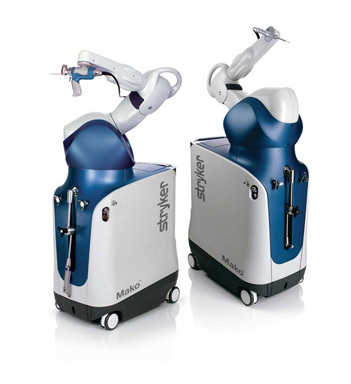Mako is a technique used by surgeons for partial knee resurfacing, total knee replacement and total hip replacement. It is an innovative treatment option for adults living with early to mid-stage joint degeneration of the hip or knee.
What makes Mako surgery different?
The difference is in the procedure’s high level of accuracy and precision. Surgeons use a robotic-assisted arm which offers greater visibility during surgery, enabling them to more precisely place and align the implants used in both knee and hip replacement procedures. It assists surgeons in pre-planning and treating each patient uniquely.
Your physician should discuss the specific risks associated with Mako Robotic-Arm Assisted Surgery and other treatment options with you. In addition, you should be informed of any pre-operative and post-operative instructions by your surgeon or his or her staff. Whether your condition is mild or severe, your physician will recommend certain lifestyle changes to reduce stress on your joints before surgery.
How It Works
Before surgery
It all begins with a CT scan of your knee or hip joint, which is used to generate a 3D virtual model of your unique anatomy. This virtual model is loaded into the Mako System software and used by your surgeon to create a personalized pre-operative plan.
In the Operating Room
In the operating room, your surgeon will use the Mako System to assist in performing your surgery based on your personalized pre-operative plan. When the surgeon prepares the bone for the implant, the surgeon guides the robotic-arm within the pre-defined area and the Mako System helps the surgeon stay within the planned boundaries that were defined when the personalized pre-operative plan was created. The Mako System also allows your surgeon to make adjustments to your plan during surgery as needed. In a laboratory study, Mako demonstrated accurate placement of implants to a personalized surgical plan. It also showed that Mako Total Knee replacement demonstrated soft tissue protection to the ligaments around the knee.
After Surgery
After surgery, your surgeon, nurses and physical therapists will set goals with you to get you back on the move. They will closely monitor your condition and progress. Your surgeon may review a post-operative x-ray of your new joint with you.
Frequently asked questions
Q: Is Mako covered by health insurance providers?
A: We understand that making sure your joint replacement is covered by health insurance is important to you. Check with your health insurance provider to verify your specific coverage.
Q: How long has the Mako procedure been available?
A: The first Mako procedure was a partial knee replacement performed in June of 2006. Since that time, over 83,000 Mako hip and knee replacement procedures have been performed around the world. Hartford Hospital performed its first Mako procedure in October 2014, and was the first in the state to perform the first total knee replacement using Mako in November 2016.
Q: Does the Mako robotic-arm actually perform surgery?
A: No, the robotic-arm doesn’t perform surgery, nor can it make decisions on its own or move without the surgeon guiding it.
Q: How long do knee implants last?
A: Individual results vary and not all patients will have the same postoperative recovery and activity level. The lifetime of a knee replacement is not infinite and varies with each individual.
Eligibility
Mako is an option for adults living with early to mid-state osteoarthritis in the knee and hip, or people who suffer from degenerative joint disease. Talk to one of our orthopedic surgeons to see if Mako is an option for you.